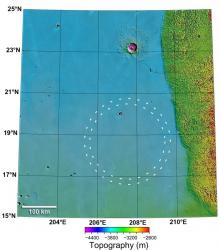 Many photographs have been taken of Martian landscapes, but now spacecraft are looking beneath the surface to see what’s buried underground. Researchers used instruments on board ESA’s Mars Express orbiter to detect ancient impact craters beneath the smooth surface of Mars’ northern hemisphere. Some of these craters were formed billions of years ago, but have been resurfaced and buried by lava flows and sediments from winds and water.
Many photographs have been taken of Martian landscapes, but now spacecraft are looking beneath the surface to see what’s buried underground. Researchers used instruments on board ESA’s Mars Express orbiter to detect ancient impact craters beneath the smooth surface of Mars’ northern hemisphere. Some of these craters were formed billions of years ago, but have been resurfaced and buried by lava flows and sediments from winds and water.
Continue reading “Finding Buried Craters on Mars”
Proton Launches MEASAT-3 Satellite
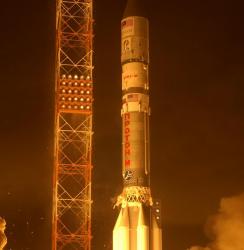 A Proton Breeze M rocket blasted off from the Baikonur cosmodrome on Monday, carrying a MEASAT-3 communications satellite into orbit. The launched at 23:28 UTC, and the satellite was released into a geosynchronous orbit 9 hours later. When it reaches its final orbit, MEASAT-3 will provide satellite broadcast and data services to customers in Southeast Asia.
A Proton Breeze M rocket blasted off from the Baikonur cosmodrome on Monday, carrying a MEASAT-3 communications satellite into orbit. The launched at 23:28 UTC, and the satellite was released into a geosynchronous orbit 9 hours later. When it reaches its final orbit, MEASAT-3 will provide satellite broadcast and data services to customers in Southeast Asia.
Continue reading “Proton Launches MEASAT-3 Satellite”
Detailed Ice Layers Revealed on Mars
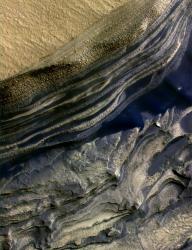 Amazing new images taken by NASA’s Mars Reconnaissance Orbiter show layers of ice deposits near the Martian poles. The polar layers are at the top of the image, while the darker materials at the bottom might have been deposited as sand dunes. The Martian ice has mixed with dust to give it the reddish hue.
Amazing new images taken by NASA’s Mars Reconnaissance Orbiter show layers of ice deposits near the Martian poles. The polar layers are at the top of the image, while the darker materials at the bottom might have been deposited as sand dunes. The Martian ice has mixed with dust to give it the reddish hue.
Continue reading “Detailed Ice Layers Revealed on Mars”
Watch for the Geminids on Wednesday
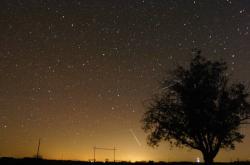 One of the best meteor showers of the year – the Geminids – are about to peak. If you’ve got clear skies, head out on the evening of December 13th, and you could see a few meteors an hour. Unlike most meteor showers, the source of the Geminids is a bit of a mystery, since the dust doesn’t seem to originate from a comet. A small asteroid called 3200 Phaethon has been discovered in the right orbit, but astronomers aren’t sure how it could be generating enough dust to cause such beautiful meteor showers.
One of the best meteor showers of the year – the Geminids – are about to peak. If you’ve got clear skies, head out on the evening of December 13th, and you could see a few meteors an hour. Unlike most meteor showers, the source of the Geminids is a bit of a mystery, since the dust doesn’t seem to originate from a comet. A small asteroid called 3200 Phaethon has been discovered in the right orbit, but astronomers aren’t sure how it could be generating enough dust to cause such beautiful meteor showers.
Continue reading “Watch for the Geminids on Wednesday”
First STS-116 Space Walk Wraps Up
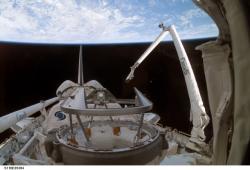 Construction is continued on the International Space Station today, when the crew of STS-116 went outside on their first spacewalk to attach the P5 truss segment. Bob Curbeam and Christer Fuglesang did the spacewalking, while Joan Higginbotham and Sunita Williams worked the robot arm to assist the construction. Two more spacewalks are planned during STS-116 to reconfigure and redistribute power generated by the solar arrays.
Construction is continued on the International Space Station today, when the crew of STS-116 went outside on their first spacewalk to attach the P5 truss segment. Bob Curbeam and Christer Fuglesang did the spacewalking, while Joan Higginbotham and Sunita Williams worked the robot arm to assist the construction. Two more spacewalks are planned during STS-116 to reconfigure and redistribute power generated by the solar arrays.
Continue reading “First STS-116 Space Walk Wraps Up”
Massive Mountain Range Seen on Titan
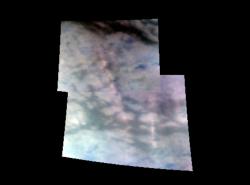 New images of Titan sent back by NASA’s Cassini spacecraft show a large mountain range, extending about 150 km (93 miles) long. The mountains were seen on Cassini’s most recently flyby on October 25, 2006, where the spacecraft captured the highest resolution infrared views of Saturn’s largest moon. They reach about 1.5 km (almost 1 mile) high, and they’re probably made of icy material, and coated with many layers of organic material.
New images of Titan sent back by NASA’s Cassini spacecraft show a large mountain range, extending about 150 km (93 miles) long. The mountains were seen on Cassini’s most recently flyby on October 25, 2006, where the spacecraft captured the highest resolution infrared views of Saturn’s largest moon. They reach about 1.5 km (almost 1 mile) high, and they’re probably made of icy material, and coated with many layers of organic material.
Continue reading “Massive Mountain Range Seen on Titan”
Podcast: We’re All Made of Supernovae
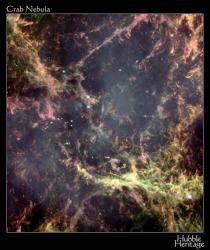 No more suspense. This week we blow the biggest stars up. Kaboom. Want more details? Then you’ve got to listen.
No more suspense. This week we blow the biggest stars up. Kaboom. Want more details? Then you’ve got to listen.
Continue reading “Podcast: We’re All Made of Supernovae”
Studies Will Proceed on Extremely Large Telescope
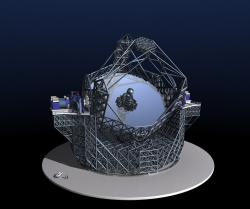 The European Southern Observatory’s governing body has agreed to proceed with detailed studies for a new, Extremely Large Telescope. The study alone has a budget of 57 million euros, and should lead to the beginning of construction in 3 years. If everything goes well, the ELT will become the world’s largest telescope, spanning 42 metres. It will have 100 times more light-gathering capacity than the largest current telescopes. The final cost will probably be more than 800 million euros.
The European Southern Observatory’s governing body has agreed to proceed with detailed studies for a new, Extremely Large Telescope. The study alone has a budget of 57 million euros, and should lead to the beginning of construction in 3 years. If everything goes well, the ELT will become the world’s largest telescope, spanning 42 metres. It will have 100 times more light-gathering capacity than the largest current telescopes. The final cost will probably be more than 800 million euros.
Continue reading “Studies Will Proceed on Extremely Large Telescope”
Heavy Stars Embedded in NGC 6357
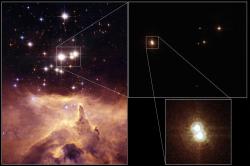 This Hubble photograph shows star cluster Pismis 24, which lies at the heart of emission nebula NGC 6357. The stars are some of the most massive ever seen in our galaxy, each of which weighs at least 100 times the mass of our Sun. Astronomers originally thought it was two stars, each of which exceeded the theoretical limits on stellar size. Hubble discovered that it’s actually three stars, bringing the reality back in line with theory.
This Hubble photograph shows star cluster Pismis 24, which lies at the heart of emission nebula NGC 6357. The stars are some of the most massive ever seen in our galaxy, each of which weighs at least 100 times the mass of our Sun. Astronomers originally thought it was two stars, each of which exceeded the theoretical limits on stellar size. Hubble discovered that it’s actually three stars, bringing the reality back in line with theory.
Continue reading “Heavy Stars Embedded in NGC 6357”
What’s Up this Week: December 11 – December 17, 2006
Greetings, fellow SkyWatchers! We’ll start off the week in living color and end it fishing for galaxies in Pices. Along the way, we’ll have a look at the dark side as we study obscuration nebula… and you won’t have to say “Betelguese” three times to study this bright star! If you were disappointed in missing this year’s Leonid meteors, then you better watch out and you better not pout… Because the Geminids are coming to town! I’ll race you to dark skies, because…
Here’s what’s up!
Continue reading “What’s Up this Week: December 11 – December 17, 2006”
